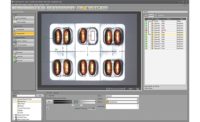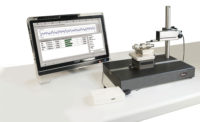The committee is working to revise the American Society of Mechanical Engineer's (ASME) B46.1-1995 Surface Texture standard. The group has added chapters to reflect the explosion of new surface measuring equipment and analysis methods. The standard should be published in about a year.
"The ASME surface metrology standards are really providing a tool box," says committee chairman Mark Malburg, Ph.D., of Digital Metrology Solutions (Columbus, IN). "It keeps all the tools in it. Here are all the different measuring methods. Here are all the difference parameters. We are just constantly building on the tool box."
More knowledge needed
The strength of the current document, and more so in the revised version, is its educational components. It describes a number of equipment and methods, and how they can be used to analyze surfaces.
"The B46 standard has in it not only the actual standard -- the typical things to do when you think of measurement -- but there is a lot of tutorial information for educating people in surface metrology," says Donald Cohen, Ph.D., of Michigan Metrology (Livonia, MI). Cohen is also vice chair of the B46 committee. "If you go to a library, it would be hard to find a good set of books on surface metrology that could help you figure it all out. B46 pulls it all together in a really nice, tutorial way."
The reference book-cum-standard includes recommended procedures and settings that can help guide an engineer. It is also important when legal issues are raised. "I've been in cases as an expert witness where that standard was cited and was the deciding factor on whether something was done correctly or not," Cohen says.
Beyond legal issues, the B46 standard is a map for engineers, too many of whom do not know enough about the topic. The B46 standard surface texture affects the function of a wide range of industrial products from mechanical parts to optics and semiconductors to road surfaces. Surface textures are important specifications for these products and countless others.
"I look at drawings all day long where surfaces are marked and not given the right specification," says Cohen. "One time, a drawing was written in English measurements and the call out was 20 microinches average roughness, which is a reasonably smooth surface. Later, they decided that they were going to convert the drawing to metric. They made the conversion but nobody really understood surface finishing and so they left it at 20. But now that they converted to metric, the drawing read 20 microns, and 20 microns are a lot bigger than 20 microinches.
"People were making parts that weren't working and they didn't know why," Cohen adds. "The vendor was making the parts to spec, as far as he knew, based on the drawing. But he didn't have the right specs and nobody knew what it really meant. That is when consultants are called in to figure it all out."
Why now?
The first publication of the standard was in 1947 and it was a stylus-based standard, which was, and some say still is, the dominant instrument for surface-texture analysis. Through revisions in the 1960s, 1970s and 1980s, the standard didn't change much, but then came an explosion of technology.
The standard revision cycle is usually five years, but from 1985 to 1995 the standard was not revised, Cohen says because of the improvements and fundamental changes in surface metrology. Not just in terms of surface equipment and applications, but that time frame also saw the advent of desktop computers.
"Now all these stylus devices and optic devices and everything else are able to take the profilometry data and really begin to do sophisticated analysis," says Cohen.
For example, in 1978 the standard addressed 2-D profiles. But, by 1995 the instruments were producing 3-D surface profiles, and parameters were needed to address the 3-D nature of surfaces.
As changes occurred, the standard saw numerous appendices attached to it. These appendices were informational in nature and not a part of the standard itself. One charge for the standards committee was to get this information that was in the back of the standard as reference material and pull it forward into the standard proper.
Filtering, fractal and nano
The new standard tackles a number of issues including filtering data, fractal analysis and nanomeasurement.
Filtering may be the biggest issue when it comes to surface analysis. In many ways, it is one of the least understood aspects of surface texture analysis and one that sometimes leads to lawsuits, according to Cohen.
When a surface is measured, it includes the actual surface profile that is acquired by the instrument. Before that profile is operated on and surface roughness numbers derived, filtering must occur that removes the basic shape of the profile. There are different ways of filtering data and each can lead to different measurement results. As a result, users can get into trouble because many drawings will specify a roughness value, but will not specify the kind of filtering required. It is sometimes left up to the user to figure out what filtering technique to use. The standard incorporates the various filters and cut off values available.
Malburg provides perhaps the easiest to understand example of filtering. A computer sitting in the middle of a desk causes the desk to sag. "The sag produces long wavelengths and that would be considered its form, or the overall shape of the surface," he says. "If you have a desk that is laminated with a veneer and is wavy because the glue was thick and thin in spots when they put on the veneer, the ripples and waves along the surface are what we call waviness--which represents the middle wavelengths. Finally, the texture that is felt when sliding a fingernail across it would be roughness and those are short wavelengths.
"When we filter," he adds, "is we take that whole table surface, that has form and waviness and roughness and we do a moving average through that, smooth out different elements of it and look at what we have left over. The filtering job is to separate data into long and short wavelengths or into waviness and roughness."
Nanometer measurement
More and more applications for nanomeasurement are appearing and the standard needs to address these measurements that are made with optics, a stylus and advanced techniques such as fractal analysis.
Theodore Vorburger, Ph.D. of the National Institute of Standards and Technology (Gaithersburg, MD), editor and past chair of the B46.1 document, points to the importance of nanometer-level measurement and its inclusion in B46.
"The nanometer level surface texture measurement is important because it is the measurement of very smooth surfaces and very smooth surfaces are becoming more and more technologically important," Vorburger says. "Surfaces such as optics, semiconductors, and even the surface of smooth mechanical parts are becoming more and more used. All of those parts have roughness down in the nanometer level -- say 100 nanometers or less."
Fractal analysis
Most people think in terms of Euclidean geometry, but to understand fractal analysis, it helps to take a quick lesson in fractal geometry, according to Chris Brown, manufacturing engineering program director and surface metrology lab director, at the Worchester Polytechnic Institute (Worcester, MA).
"Fractal geometry is the geometry of things that are fractured or fragmented, jagged or irregular," says Brown. "Almost all surfaces have got some of the characteristics at a sufficiently fine scale."
For instance, when a part is magnified enough in a traditional way, the shape will eventually look smooth. But according to Brown, with fractal analysis when that same part is magnified with an atomic force microscope, more irregularities are constantly observed.
Finding this irregularity can be used to reject a part, but sometimes that irregularity can be put to work. One example, Brown says, is to try and adhere a thermal spray coating to a substrate. Adhesion strength depends on the topography the material can hold onto.
"When trying to model something like adhesion on a substrate, you need to take into account the fractal nature of the substrate in order to have a good model and predict the good adhesive strength," Brown says. "Using fractal analysis we have been able to predict adhesive strength based on substrate roughness with correlation coefficients of 0.9, which means that 90% of the differences in adhesive strength can be explained by differences in substrate roughness. And that we have done using fractal analysis."
More to come
These changes are just some that can be expected in the future. The standard, according to committee members, is a dynamic and growing document that changes with the times. Project teams are already working on new topics such as functional correlation of gages and 3-D surface texture.
One area that is somewhat in flux is the standard's relationship to the ISO surface standard. According to the experts, both standards have their positives and negatives. One advantage of the ISO standard is that it is an objective, direct standard that says, "Here's how you do this, here's how you do that." The B46 standard is more tutorial. It is meant to be a good reference book as well as a standard.
"The international standards are written as somewhat of an arbitrator," says Malburg. "Unless otherwise specified, this is what you do and it gives one method. The American B46 standard says here are many methods, some that have been used in the past, some that are new. Use the one that best fits your application. It gives a little more tutorial help, and ultimately puts the responsibility on the end user in terms of how to use it."
The ASME standard also keeps older technology on the books, so to speak. For instance, in the ISO standard, 2RC filtering is no longer described in favor of gaussian filtering. However, in the ASME standard, both types of filters are included. "We did this in order to keep this standard compatible with instruments that were in use even before the advent of personal computers," explains Vorburger.
TECH TIPS
The new surface texture revises the 1995 version and is scheduled to be published in about a year.
The standard offers requirements but is also a tutorial explaining surface texture in user-friendly terms.
The standard takes into account the new types of measurement equipment such as atomic force scale and optical equipment.
The new version includes new information on such topics as filtering, fractal analysis, nanomeasurement and optical measurement.

